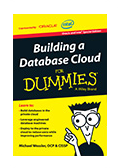Building a Database in the Cloud? E-Book Explains How.
It’s free for download as long as you have a free Oracle account.
Clear and concise, practical, filled with time-saving tips—the reviews are in on Building a Database Cloud for Dummies.
This quick-reference guide, organized into six short chapters and supplemented with helpful illustrations, provides a clear overview of the cloud and step-by-step instructions on deploying database as a service. Download the complimentary e-book today and learn how to:
- Build a vision and business case for the cloud
- Operate and deploy a database in the private cloud
- Maximize success, with a list of the top 10 things to consider when starting
Cloud Database
Cloud database allow businesses to drive down costs while increasing business agility and IT performance. See for yourself how to save money, simplify management, and improve resource efficiency with a database cloud.

























